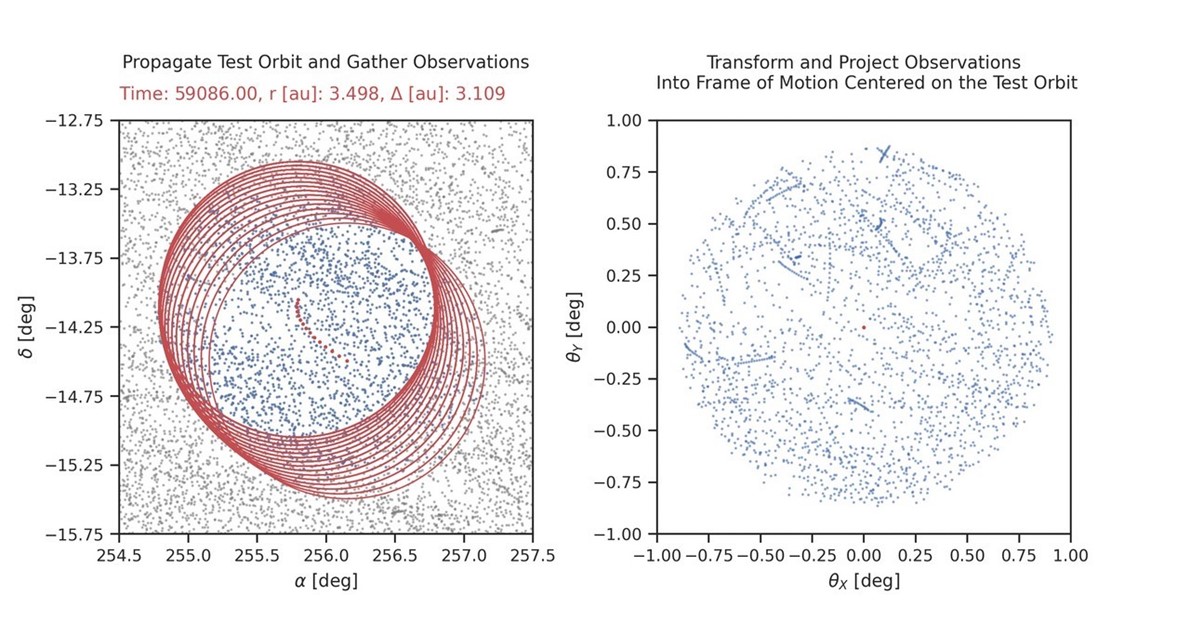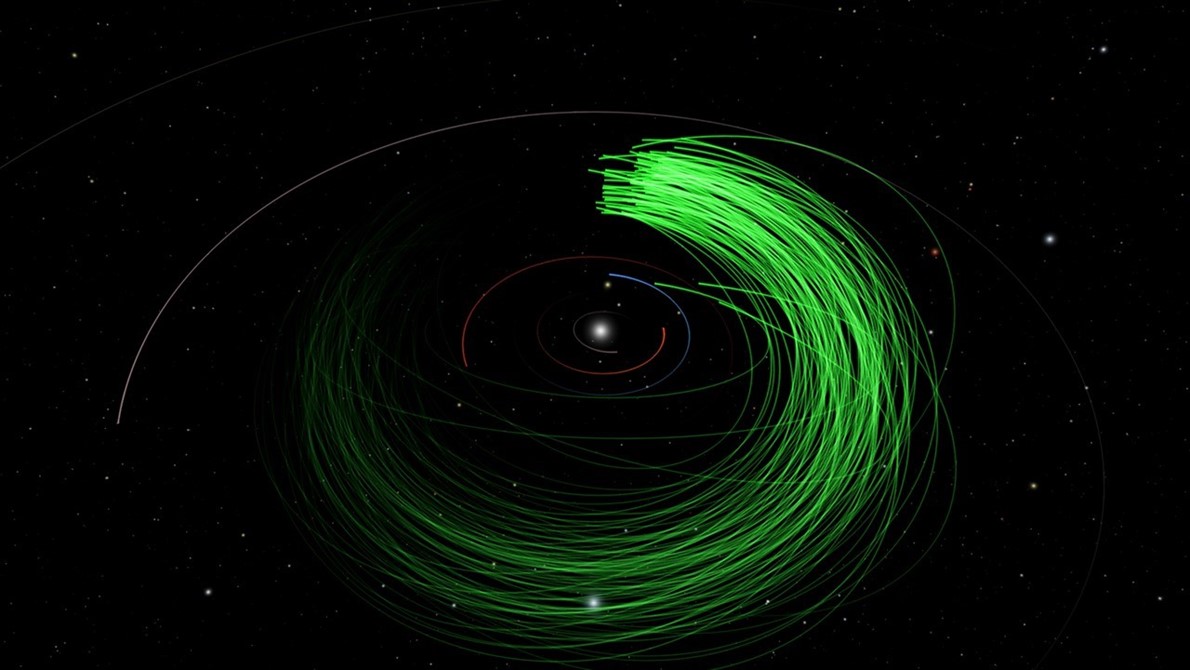Ed Lu wants to save Earth from killer asteroids.
Or at least, if
there is a big space rock streaking our way, Lu, a former
NASA astronaut with a
doctorate in applied physics, wants to find it before it hits us — hopefully
with years of advance warning and a chance for humanity to deflect it.
اضافة اعلان
On Tuesday, B612
Foundation, a nonprofit group that Lu helped found, announced the discovery of
more than 100 asteroids. (The foundation’s name is a nod to Antoine de
Saint-Exupéry’s children’s book “
The Little Prince”: B612 is the home asteroid
of the main character.)
That by itself is
unremarkable. New asteroids are reported all the time by sky-watchers around
the world. That includes amateurs with backyard telescopes and robotic surveys
systematically scanning the night skies.
What is remarkable
is that B612 did not build a new telescope or even make new observations with
existing telescopes. Instead, researchers financed by B612 applied cutting-edge
computational might to years-old images — 412,000 of them in the digital
archives at the National Optical-Infrared Astronomy Research Laboratory, or
NOIRLab — to sift asteroids out of the 68 billion dots of cosmic light captured
in the images.
“This is the
modern way of doing astronomy,” Lu said.
The research adds
to the “planetary defense” efforts undertaken by NASA and other organizations
around the world.
 An undated image from University of Washington DiRAC Institute/B612 Asteroid Institute provides a visualization of an algorithm known as Tracklet-less Heliocentric Orbit Recovery, or THOR, that searches for asteroids by viewing observations from a vantage point of an object moving along a hypothetical “test orbit.” Viewed that way, previously hidden nearby asteroids become easily recognizable as nearly straight lines.
An undated image from University of Washington DiRAC Institute/B612 Asteroid Institute provides a visualization of an algorithm known as Tracklet-less Heliocentric Orbit Recovery, or THOR, that searches for asteroids by viewing observations from a vantage point of an object moving along a hypothetical “test orbit.” Viewed that way, previously hidden nearby asteroids become easily recognizable as nearly straight lines.
Today, of the
estimated 25,000 near-Earth asteroids at least 460 feet in diameter, only about
40 percent of them have been found. The other 60 percent — about 15,000 space
rocks, each with the potential of unleashing the energy equivalent to hundreds
of million of tons of TNT in a collision with Earth — remain undetected.
B612 collaborated
with Joachim Moeyens, a graduate student at the University of Washington, and
his doctoral adviser, Mario Juric, a professor of astronomy. They and
colleagues at the university’s Institute for Data Intensive Research in
Astrophysics and Cosmology developed an algorithm that can examine astronomical
imagery not only to identify those points of light that might be
asteroids, but
also to figure out which dots of light in images taken on different nights are
actually the same asteroid.
Today, of the estimated 25,000 near-Earth asteroids at least 460 feet in diameter, only about 40 percent of them have been found.
In essence, the
researchers developed a way to discover what has already been seen but not
noticed.
Typically,
asteroids are discovered when the same part of the sky is photographed multiple
times during the course of one night. A swath of the night sky contains a
multitude of points of light. Distant stars and galaxies remain in the same
arrangement. But objects that are much closer, within the solar system, move
quickly, and their positions shift over the course of the night.
Astronomers call a
series of observations of a single moving object during a single night a
“tracklet.” A tracklet provides an indication of the object’s motion, pointing
astronomers to where they might look for it on another night. They can also
search older images for the same object.
Many astronomical
observations that are not part of systematic asteroid searches inevitably
record asteroids, but only at a single time and place, not the multiple
observations needed to put together tracklets.
The NOIRLab
images, for example, were mainly taken by the Victor M. Blanco 4-Meter
Telescope in Chile as part of a survey of almost one-eighth of the night sky to
map the distribution of galaxies in the universe.
The additional
specks of light were ignored because they were not what the astronomers were
studying. “They’re just random data in just random images of the sky,” Lu said.
But for Moeyens
and Juric, a single point of light that is not a star or a
galaxy is a starting
point for their algorithm, which they named Tracklet-less Heliocentric Orbit
Recovery, or THOR.
The motion of an
asteroid is precisely dictated by the law of gravity. THOR constructs a test
orbit that corresponds to the observed point of light, assuming a certain
distance and velocity. It then calculates where the asteroid would be on
subsequent and previous nights. If a point of light shows up there in the data,
that could be the same asteroid. If the algorithm can link together five or six
observations across a few weeks, that is a promising candidate for an asteroid
discovery.
 An undated image from B612 Asteroid Institute/University of Washington DiRAC Institute/OpenSpace Project, shows a visualization of asteroid trajectories through the solar system, in green, with Earth’s orbit in blue. Venus’s and Mars’s orbits are in red, and Mercury’s and Jupiter’s orbits are in brownish-gray.
An undated image from B612 Asteroid Institute/University of Washington DiRAC Institute/OpenSpace Project, shows a visualization of asteroid trajectories through the solar system, in green, with Earth’s orbit in blue. Venus’s and Mars’s orbits are in red, and Mercury’s and Jupiter’s orbits are in brownish-gray.
So far, the
scientists have sifted through about one-eighth of the data of a single month,
September 2013, from the NOIRLab archives. THOR churned out 1,354 possible
asteroids. Many of them were already in the catalog of asteroids maintained by
the International Astronomical Union’s Minor Planet Center. Some of them had
been previously observed, but only during one night and the tracklet was not
enough to confidently determine an orbit.
For B612, instead of wrangling a telescope project costing almost a half-billion dollars, it can contribute with less expensive research endeavors such as THOR.
The Minor Planet
Center has confirmed 104 objects as new discoveries so far. The NOIRLab archive
contains seven years of data, suggesting that there are tens of thousands of
asteroids waiting to be found.
NASA is
accelerating its planetary defense efforts. Its asteroid telescope, NEO
Surveyor, is in the preliminary design stage, aiming for launch in 2026.
And later this
year, its Double Asteroid Redirection Test mission will slam a projectile into
a small asteroid and measure how much that changes the asteroid’s trajectory.
China’s national space agency is working on a similar mission.
For B612, instead
of wrangling a telescope project costing almost a half-billion dollars, it can
contribute with less expensive research endeavors such as THOR. Last week, it
announced that it had received $1.3 million of gifts to finance further work on
cloud-based computational tools for asteroid science. It also received a grant
from Tito’s Handmade Vodka that will match up to $1 million from other donors.
B612 and Lu are
now not just trying to save the world. “We’re the answer to a trivia question
of how vodka is related to asteroids,” he said.
Read more Technology
Jordan News



